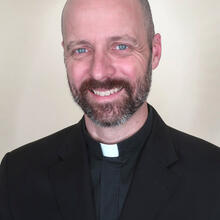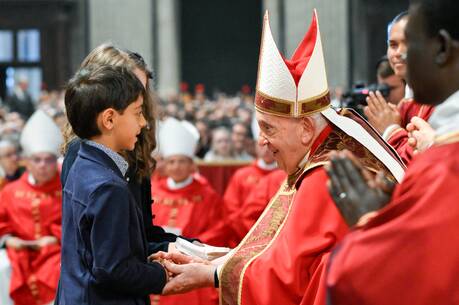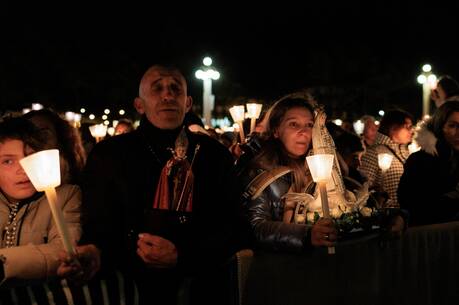Expectant mothers often speak to their babies before they are born: “Love you! Can’t wait to see you!” They ask God to care for them: “Father, protect this child. Keep me safe and healthy.” We may presume that Mary, as a woman of faith and love, did this, too. In many other ways, as well, she probably looked like an ordinary pregnant young woman, going about her daily chores and activities. Of course, although she looks ordinary, we know she is extraordinary. She is the mother of God. In her womb, for the first time in history, God becomes human. She carries him quietly and powerfully. She is a living tabernacle.
Mary reminds us that we, too, carry Christ within us after receiving Communion, as living tabernacles. She helps us to see anew the meaning and purpose of the tabernacle each time we are at Mass, holding within it the Eucharist, the body of Christ.
The Catholic practice of having a tabernacle is rooted in Jewish tradition. God instructs Moses in the Book of Exodus to build a tabernacle; it is to be a box made of acacia wood, covered in gold, with a golden angel on either end (Ex 25). This ark, or tabernacle, will hold the covenant, the stone tablets given to Moses on Mount Sinai. Further, God instructs his people to creat a large tent that will encircle the ark; they are to gather in this area for prayer and worship. In a sense, there are three tabernacles in one: God dwells in the central ark, with Moses in the tent, and the people gathered in the surrounding space.
The people use this worship area every sabbath. Afterward, the Jewish people fold it up and bring it with them on their 40-year journey. Each week, they unfold it again and set up a sort of mobile worship site. The ark is likewise constructed for a journey, as it hangs from four golden rings affixed to two long wooden poles, carried on the shoulders of several travelers.
According to some traditions, the ark also included pieces of manna, the bread from heaven given by God to sustain his people during the Exodus. There in the Holy of Holies, God promises to dwell with them on their long and dangerous trek through the desert to the promised land. Later in Jerusalem, under the rule of Kings Saul and David and Solomon, a permanent tabernacle is erected in the great Temple. In the church, we see our practice of keeping the Eucharist as a fulfillment of the Temple—holding Jesus, the living bread within.
There is a healthy tension in these traditions. The Jewish people understood that God reigns over the whole world. Yet he was especially present in the tabernacle tent and even more in the ark. After Moses speaks with God, the skin on his face glows. The people find this so unnerving that they ask him to place a veil over his face—so that Moses remains “tented” throughout the day. Catholics agree that God is infinite, and thus everywhere. Yet God is truly present in the person of Jesus, “God with us.” And Jesus gives us the Eucharist as an abiding real presence of his body and blood.
One title of Mary in various Catholic litanies is Ark of the Covenant, connecting her with the Exodus tabernacle.
Mary is a bridge among these different types of tabernacle. She helps us to bring the presence of God into our daily lives. For nine months, she carried the living God within her, as the child Jesus grew in her womb. One title of Mary in various Catholic litanies is Ark of the Covenant, connecting her with the Exodus tabernacle. She travels with us on our Advent journey, carrying Jesus within her even as we await his final coming.
The eucharistic tabernacle is likewise a meeting place between God and humanity. When I was teaching high school, I would bring the boys to the school chapel during class in Advent and Lent. I asked them to take time in quiet for prayer, journaling or making an examen. The chapel was a place of prayer, centered on Christ. Also, from the tabernacle I have distributed the Eucharist to the sick and elderly who are not able to attend Mass. God goes out to meet his people through the Eucharist.
The eucharistic tabernacle is likewise a meeting place between God and humanity.
We, too, are living tabernacles. At every Mass, the eucharistic minister says, “the body of Christ,” and we reply, “Amen,” “Yes, I believe”; and then I receive the host. I carry the living God within me. I love to distribute Communion at Mass. I see little toothy smiles filled with hope and excitement. I see old faces, marked with age and pain, yet with an ageless trust. I see the eyes of young parents, tired and loving.
In the Spiritual Exercises, St. Ignatius invites retreatants to ponder how “God dwells also in myself, giving me existence, life, sensation, and intelligence; and even further, making me his temple, since I am created as a likeness and image of the Divine Majesty” (No. 235).
I am his tabernacle. So are you. The Incarnation continues in the church, the body of Christ. The incarnate God dwells in me and in you. This Advent, we honor Mother Mary for her great yes to God’s grand invitation to bear Christ within her. We look to the manger with wonder and awe as the infinite God becomes a tiny child for us. We adore Christ in the Eucharist, present in every tabernacle in every Catholic church in the world. And we look to our own hearts, where God has chosen to dwell, “making me his temple.”








